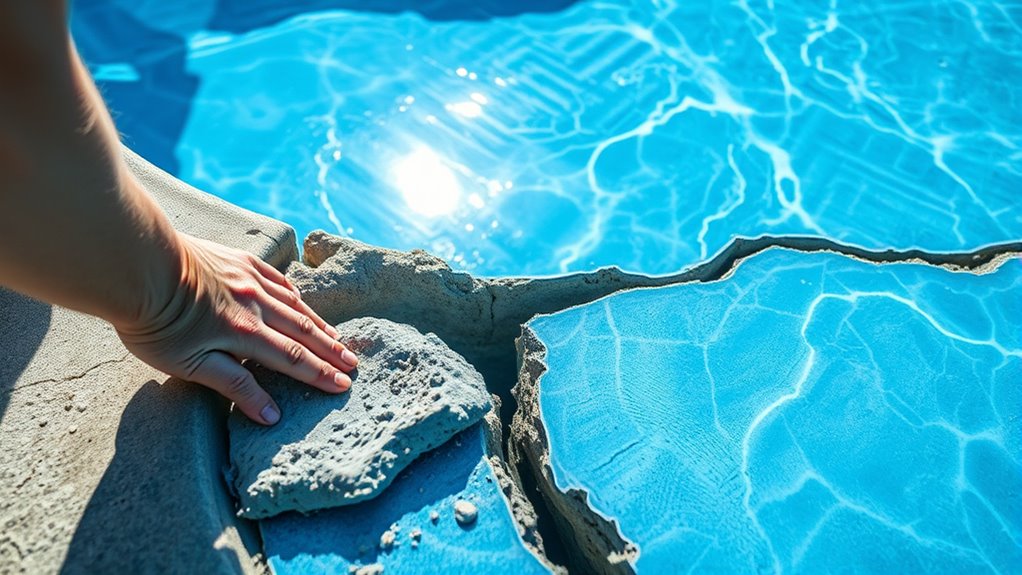To fix cracks in your concrete pool, start by identifying the crack type and severity. Drain the pool, clean the area thoroughly, and remove loose debris. For small cracks, apply a high-quality epoxy or patch compound after surface prep. For larger or structural cracks, use hydraulic cement or epoxy injection, ensuring proper curing. Regular inspection and maintenance help prevent future issues. If you want to learn detailed repair techniques and tips, you’ll find useful insights ahead.
Key Takeaways
- Identify crack type and severity to determine if simple patching or professional repair is needed.
- Drain the pool, then thoroughly clean and dry the affected area before applying repair materials.
- Use high-quality epoxy or hydraulic cement to fill small or structural cracks, following proper mixing and application procedures.
- For large or active cracks, consider consulting a professional structural engineer for assessment and specialized repairs.
- Regularly inspect and maintain the pool to prevent future cracks and address minor issues early.
Identifying Different Types of Cracks in Concrete Pools
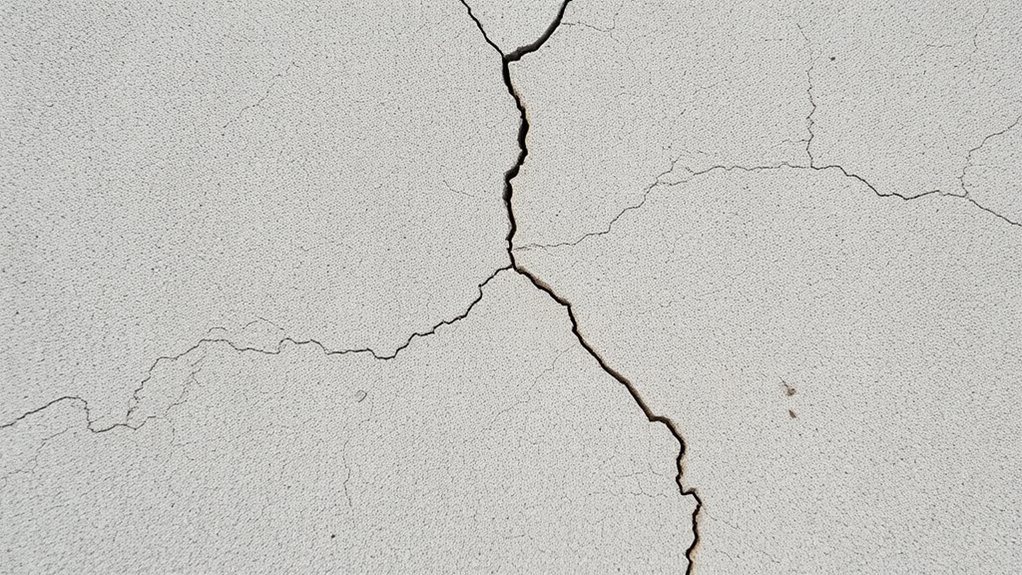
Understanding the different types of cracks in your concrete pool is essential for proper repair. When you examine your pool, look closely at the cracks’ appearance and location. Vertical or diagonal cracks often indicate settling or minor shifting, but they might not require immediate repairs. Horizontal cracks, on the other hand, can suggest serious structural issues and need prompt attention. Hairline cracks are thin, often caused by surface shrinkage, and usually aren’t urgent. Larger, jagged cracks could point to foundational problems or freeze-thaw damage. By identifying these differences early, you gain insight into what repair methods are necessary. Properly classifying cracks helps you determine whether a simple patch will suffice or if professional intervention is needed to ensure your pool’s longevity. AI security monitoring and assessment techniques can assist in evaluating the severity of more complex structural issues, ensuring timely and effective repairs. Additionally, understanding drainage and soil conditions around the pool area can help prevent further cracking and deterioration over time. Regular inspections and understanding soil stability are key to maintaining a durable concrete pool. Proper evaluation of these crack types, combined with soil condition analysis, can significantly improve your pool’s longevity and safety.
Assessing the Severity of Pool Cracks

Evaluating the severity of cracks in your concrete pool is essential for determining the appropriate repair approach. First, look at the crack’s width: hairline cracks are generally minor, while wider cracks indicate more significant issues. Next, check the crack’s length and whether it’s spreading or stable. Active cracks that grow over time suggest ongoing structural problems, whereas stationary cracks are less urgent. Also, observe if water is leaking through the crack or if there’s visible displacement of the concrete. Collecting this information helps you understand if the crack is superficial or a sign of underlying structural damage. Incorporating sound healing science concepts, like assessing vibrations around the crack, can sometimes provide additional insights into underlying issues. Additionally, consulting with a structural engineer can provide a more comprehensive assessment of structural integrity and guide effective repair strategies. Regular monitoring and documentation of crack progression can also aid in early detection of potential problems, especially when combined with vibration analysis techniques that help detect hidden structural stresses. Understanding material properties can further assist in predicting how the concrete may behave over time under various conditions.
Preparing Your Pool for Repair

Before you start repairs, you need to drain and thoroughly clean your pool to remove debris and guarantee a clear working surface. Next, carefully assess the extent of the damage so you know what repairs are needed. Taking these steps will help you achieve a solid, long-lasting fix. Additionally, inspecting the surrounding environment ensures your repairs align with environmental considerations, promoting sustainable and responsible maintenance. Considering data privacy concerns related to pool monitoring systems can also help ensure your safety and privacy during repairs. To ensure your repair process is effective and safe, consulting with a Best Vacuum Expert can provide valuable insights into maintaining a clean and healthy environment around your pool. Understanding the history of pool construction can also help identify potential underlying issues that may affect repair decisions.
Drain and Clean Pool
Have you ever wondered why proper preparation is essential before repairing your concrete pool? Draining and cleaning your pool ensures a solid foundation for repairs. First, you’ll want to:
- Turn off the pool pump and drain the water completely, exposing any cracks or damage.
- Use a brush or pressure washer to scrub away algae, dirt, and debris from the surface.
- Inspect the pool’s interior for loose debris or lingering residue that could interfere with epoxy or concrete patching.
This process reveals all cracks and imperfections clearly, allowing you to focus on effective repairs. It also guarantees that bonding agents adhere properly, preventing future issues. Properly drained and cleaned pools create the ideal environment for durable, long-lasting fixes.
Assess Damage Extent
After draining and cleaning your pool, it’s time to assess how extensive the damage is. Carefully inspect the cracks and surrounding areas for signs of widening, spalling, or water leakage. Measure the length, width, and depth of each crack to determine their severity. Look for any additional damage, like chips or surface erosion, that may indicate underlying issues. Use a flashlight to check for hidden cracks or cracks behind pool features. Take detailed notes and photographs to document the damage for future reference. This step helps you decide whether a simple patch will suffice or if more extensive repairs are necessary. Accurate assessment guarantees you choose the right repair method and prevents further damage down the line.
Cleaning and Removing Debris From Cracks
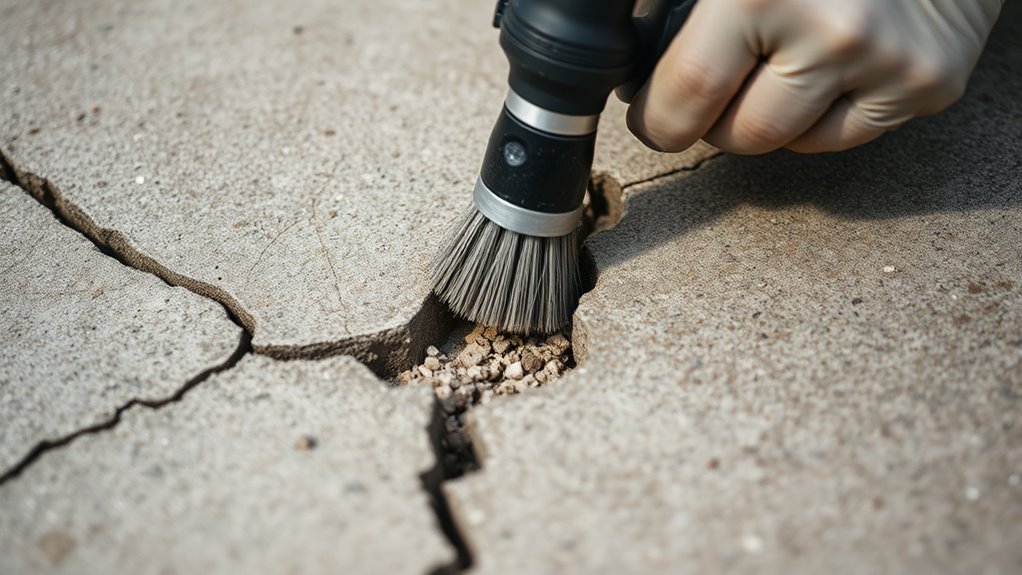
Before repairing cracks, you need to clear away any surface debris so the patch can adhere properly. Use the right tools, like a wire brush or scraper, to remove dirt and loose material effectively. Taking these steps now helps prevent future blockages and guarantees a solid, lasting repair. Additionally, inspecting the crack for structural issues can inform the best repair method and ensure long-term durability, much like performance upgrades in vehicle tuning enhance overall vehicle stability.
Clearing Surface Debris
Wondering how to guarantee a proper repair? The first step is clearing surface debris from the crack. Start by inspecting the crack closely. Then, follow these steps:
- Use a stiff brush or wire brush to scrub away dirt, loose concrete, and any algae buildup.
- Wipe the area with a damp cloth to remove dust and small particles.
- Allow the surface to dry completely before proceeding.
This process ensures no debris remains that could hinder adhesion. Visualize the crack now clean and free of obstructions, ready to accept patching material. Removing surface debris creates a solid foundation for the repair, preventing future problems. Taking your time here guarantees a smooth, durable fix that lasts longer. Proper cleaning is essential for a seamless, professional-looking repair in your pool.
Using Proper Tools
Using the proper tools is essential for effectively cleaning and removing debris from cracks in your pool. You want to guarantee all dirt, loose material, and debris are thoroughly cleared before repairing. A wire brush or small chisel helps loosen stubborn debris, while a shop vacuum or compressed air removes dust and particles efficiently. Using the right tools prevents debris from compromising the repair’s integrity. Here’s a quick guide:
| Tool Type | Purpose |
|---|---|
| Wire brush / Chisel | Loosen debris and debris buildup |
| Shop vacuum / Compressed air | Remove dirt and dust after brushing |
| Utility knife | Scrape out loose material |
| Steel brush | Clean small cracks thoroughly |
| Rags or towels | Wipe surface for dry, clean area |
Choose tools suited to your crack size and debris type for best results.
Preventing Future Blockages
To prevent future blockages in your pool cracks, regular maintenance is essential. You need to stay ahead of debris that can clog the cracks and weaken the structure. Start by inspecting the cracks weekly, looking for leaves, dirt, and algae buildup. Next, use a small brush or blower to gently remove debris from the cracks, ensuring no particles are left behind. Finally, flush the cracks with clean water or a gentle pressure hose to wash away fine dirt and prevent buildup. Visualize these steps:
- Clearing out leaves and dirt with a brush or blower, revealing the crack’s surface.
- Using a small brush or sponge to scrub away algae or stubborn debris.
- Rinsing with water to wash away loosened particles, keeping the cracks clean and debris-free. This routine keeps your pool’s structure solid and prevents future blockages.
Choosing the Right Repair Materials and Tools
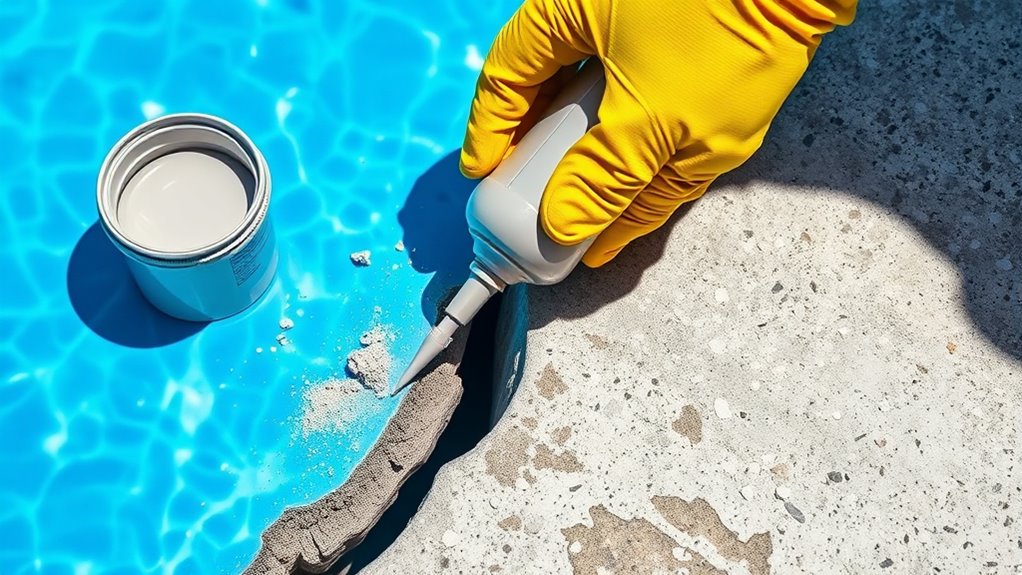
Choosing the right repair materials and tools is essential for effectively fixing cracks in your concrete pool. You need a high-quality epoxy or hydraulic cement designed specifically for pool repairs, ensuring durability and water resistance. For small cracks, a quick-setting patching compound works well, while larger cracks may require structural epoxy injections. Use tools like a chisel, wire brush, and putty knife to prepare the surface, removing loose debris and creating a solid bond. A concrete mixer or mixing paddle will help achieve the right consistency for your patching material. Always wear protective gloves and goggles to stay safe during the process. Selecting appropriate, pool-specific materials and proper tools will ensure your repair lasts and prevents further damage. Additionally, understanding the importance of waterproofing can help maintain the integrity of your pool after repairs. Proper surface preparation and choosing the right repair materials are crucial for a long-lasting fix. Incorporating vetted products from trusted brands can also enhance the durability of your repairs and prevent future cracks. When selecting materials, consider those with chemical resistance to withstand pool chemicals and water exposure over time.
Step-by-Step Guide to Filling Small Cracks

Filling small cracks in your concrete pool requires careful preparation and precise application to guarantee a lasting repair. First, clean the crack thoroughly with a brush or vacuum to remove debris and assure good adhesion. Next, use a concrete bonding agent to improve the bond between the old surface and the patch. Finally, follow these steps:
- Mix the concrete patch or epoxy according to instructions.
- Apply the mixture into the crack with a putty knife, pressing firmly to fill completely. Ensuring proper surface preparation is essential for a durable repair.
- Smooth the surface and remove excess material for a flush finish.
Allow the repair to cure fully before refilling the pool. Properly filling small cracks helps prevent water leaks and further damage, guaranteeing your pool stays in top condition. Additionally, choosing the right best concrete repair materials can enhance the durability of your fix.
Repairing Larger or Structural Cracks

When dealing with larger or structural cracks in your concrete pool, addressing them promptly is essential to prevent further damage. First, inspect the crack carefully to determine its severity and whether it’s a structural issue. Clean out the crack thoroughly, removing loose debris and old repair material. Use a chisel and hammer to widen the crack slightly, ensuring the repair material adheres well. Mix a high-strength epoxy or hydraulic cement designed for structural repairs. Apply the mixture into the crack using a putty knife or trowel, pressing it in firmly. Smooth the surface to match the surrounding pool finish. Allow the repair to cure fully before refilling the pool. Properly repairing large cracks helps maintain your pool’s integrity and prevents costly future repairs. Additionally, understanding the structural integrity of your pool can guide you in assessing whether professional intervention is necessary. Regular inspections can help identify potential issues early and avoid costly repairs down the line.
Finishing and Sealing Repaired Areas
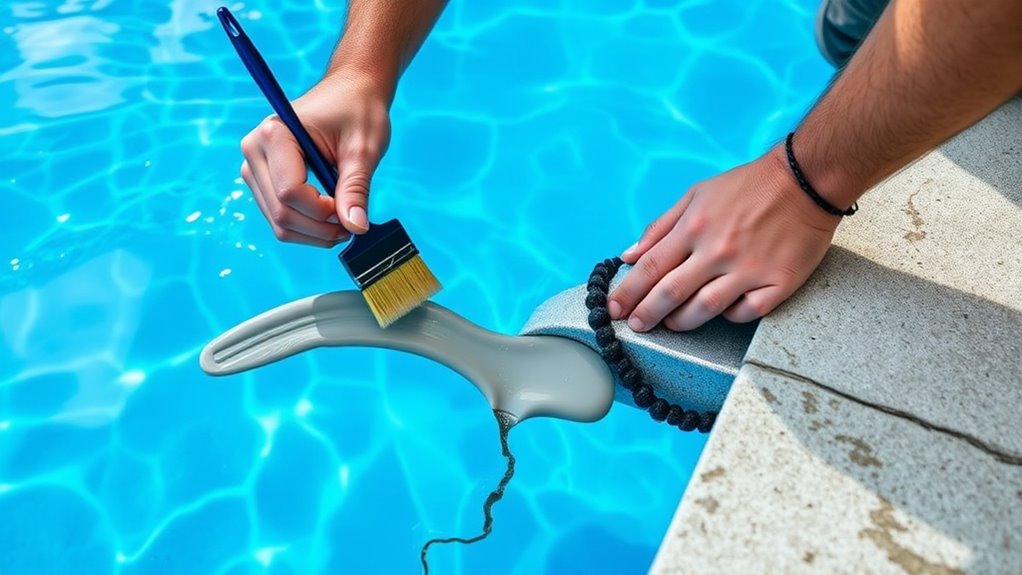
After the repair material has fully cured, the next step is to finish and seal the repaired area to guarantee a smooth, waterproof surface. First, you should use a fine-grit sanding block or a wet diamond pad to gently smooth out any rough edges or imperfections. Second, clean the area thoroughly with a damp cloth to remove dust and debris, ensuring proper adhesion of sealants. Finally, apply a high-quality waterproof sealant designed for concrete pools, covering the entire repaired section with even strokes. Imagine a consistent, glossy finish, seamlessly blending with the surrounding surface. Proper finishing and sealing protect your repair, prevent future cracks, and keep your pool watertight and visually appealing. Additionally, understanding hackathons can inspire innovative solutions for pool maintenance and repair challenges.
Preventative Measures to Minimize Future Cracks
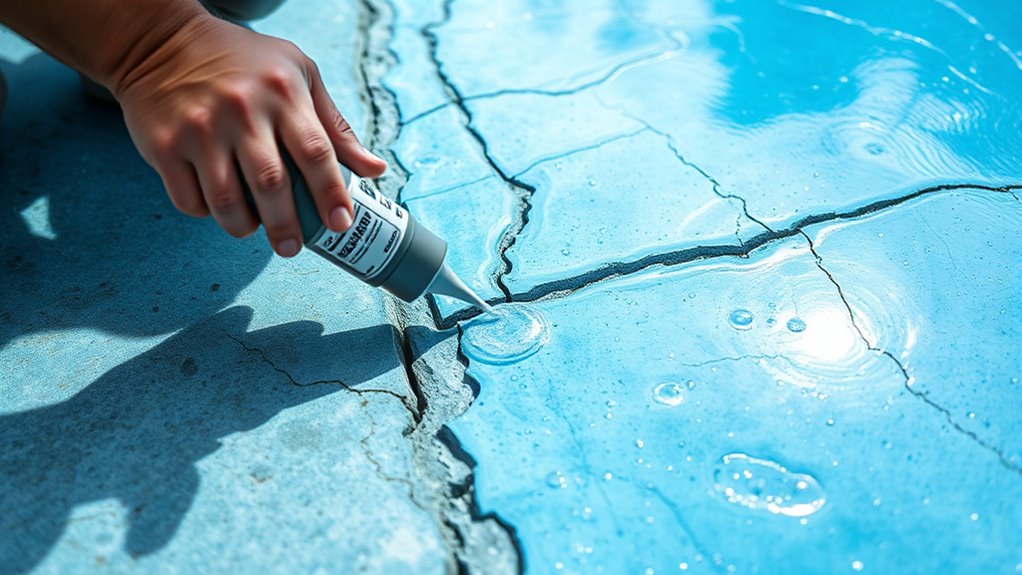
To minimize future cracks in your concrete pool, implementing proper construction and maintenance practices is essential. Start by ensuring the concrete mix has the right water-to-cement ratio to prevent weaknesses. Use control joints strategically to allow expansion and contraction without cracking. Regularly inspect the pool for early signs of damage and address issues promptly. Keep the water chemistry balanced, as improper pH levels can weaken the concrete over time. Avoid rapid temperature changes that cause stress; cover the pool during hot or cold weather. Proper drainage around the pool helps prevent water pressure buildup beneath the surface. Routine cleaning and sealing also protect the concrete from chemicals and environmental damage. Following these practices helps extend your pool’s lifespan and minimizes the risk of future cracks.
When to Seek Professional Assistance
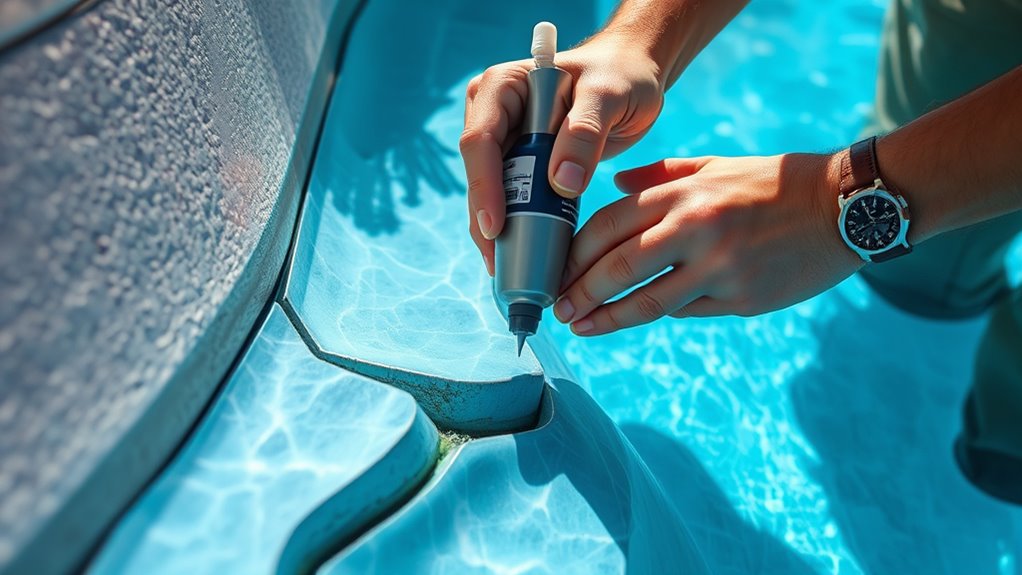
Recognizing the signs that your concrete pool needs professional help is crucial for preventing minor issues from escalating. If cracks grow larger, it’s time to call in an expert. Look for these indicators:
- Cracks wider than a quarter inch that keep widening over time
- Multiple cracks forming across different areas of the pool
- Cracks accompanied by shifting or uneven surfaces around the pool’s edge
If you notice water loss that can’t be explained by evaporation or visible structural shifts, professional assessment is essential. Ignoring these signs can lead to more severe damage, costly repairs, or compromised safety. When in doubt, consulting a pool specialist ensures proper diagnosis and effective solutions, saving you time, money, and stress in the long run.
Frequently Asked Questions
How Long Does Concrete Pool Crack Repair Typically Take?
You’re wondering how long concrete pool crack repairs typically take. Usually, the process spans from a few hours to several days, depending on the crack’s size and severity. First, you’ll need to clean and prep the area, then apply the repair material. Small cracks might be fixed in a day, but larger or more complex cracks could require multiple visits or curing time, stretching the process to about a week.
Can I Repair Cracks in a Fiberglass or Vinyl Pool?
You can repair cracks in a fiberglass or vinyl pool, but the process varies from concrete. For fiberglass, you’ll need to sand, clean, and apply a specialized gel or patch to seal cracks. Vinyl pools often require patching with compatible vinyl repair kits. You should act quickly to prevent further damage, and if cracks are large or deep, consider professional help to guarantee a durable, long-lasting fix.
Are There Eco-Friendly Repair Options for Concrete Pools?
Did you know that eco-friendly pool repairs are gaining popularity? When you’re considering repairs for your concrete pool, there are sustainable options available. You can use environmentally safe patching compounds made from natural materials or recycled content, which minimize chemical runoff. These eco-friendly solutions reduce your pool’s environmental impact without sacrificing durability. By choosing green repair options, you help protect the environment while maintaining your pool’s integrity and longevity.
How Can I Prevent Cracks Caused by Ground Movement?
You can prevent cracks caused by ground movement by ensuring proper site preparation before construction. This includes grading the area correctly and installing a stable, well-compacted base. Additionally, use flexible, high-quality concrete that can absorb some ground shifts. Incorporate control joints during pouring to guide cracking, and consider installing a soil drainage system to reduce pressure from water movement. Regular maintenance and inspections also help catch issues early.
What Are the Costs Associated With Professional Crack Repairs?
When considering professional crack repairs, you’re investing in long-term peace of mind. Costs can vary depending on the crack’s size, severity, and location, typically ranging from a few hundred to over a thousand dollars. You might find that spending a bit now saves you bigger expenses later. Remember, quality repairs protect your pool’s integrity, ensuring it stays beautiful and functional for years to come, making the investment worthwhile.
Conclusion
Think of your pool as a mirror of your home’s foundation—cracks hint at deeper issues, but with careful repair, you can restore its strength and beauty. By tending to these tiny fractures now, you’re nurturing the vessel of countless summer memories. When you mend your pool, you’re not just fixing concrete; you’re sealing in your family’s joy and safeguarding future reflections of laughter and relaxation. Protect your oasis—every crack is a call to care.
